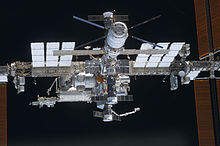Johannes Kepler ATV
Template:Infobox Cargo spacecraft The Johannes Kepler ATV, or Automated Transfer Vehicle 002 (ATV-002), is a European unmanned cargo resupply spacecraft named after German astronomer Johannes Kepler.[1][1] The spacecraft was launched on 17 February 2011[2], on a mission to supply the International Space Station (ISS) with propellant, air and dry cargo.[3] Carrying cargo weighing over 7,000 kilograms (15,000 lb), Johannes Kepler has a total mass of over 20,000 kilograms (44,000 lb).[4] It is the heaviest payload ever launched by the European Space Agency.[5] Johannes Kepler is the second ATV, following the Jules Verne mission in 2008.
Many of the supplies aboard this ATV will be used for the concurrent mission of Shuttle STS-133 and the ISS Expedition 26.[6]. A Reentry Breakup Recorder will be placed aboard before separation.[7]
Mission payload
- Section ref: NASA[8]
| Cargo | Mass |
|---|---|
| ISS reboost/attitude control propellants |
4,534 kilograms (9,996 lb) |
| ISS refuel propellant |
850 kilograms (1,870 lb) |
| Oxygen gas | 100 kilograms (220 lb) |
| Water | 0 kilograms (0 lb) |
| Dry Cargo (food, clothes, equip.) |
1,600 kilograms (3,500 lb) |
| Total: | 7,084 kilograms (15,618 lb) |
Launch

On February 16, 2011 Johannes Kepler was launched on an Ariane 5ES rocket, from the Guiana Space Centre in Kourou, French Guiana. Launch was conducted by Arianespace on behalf of the European Space Agency.
The first launch attempt on 15 February 2011 was halted during the final count down at four minutes from lift off due to an erroneous signal from one of the rocket's fuel tanks.[9]
Docking


With a 15-minute delay, docking with the space station was completed on 24 February 2011 at 15:59 UTC.[10] The spacecraft traveled over eight days to catch up with the space station and arrived at the aft port of the station's Zvezda service module. During the rendezvous operations ATV-2 traveled 2.5 million miles.The docking occurred as ATV-2 and the ISS flew near the coast of Liberia in western Africa. Hooks and latches engaged a few minutes later to firmly attach ATV-2 spacecraft to the ISS. The docking of ATV-2 allowed station managers to clear the way for the space shuttle Discovery's launch on STS-133 mission.
Station re-boost

On March 18, 2011, the Orbit Control System (OCS) thrusters of the ATV-2 spacecraft was used to re-boost the orbit of the space station. The engines were started at 06:00:00 GMT, and shut down at 06:14:42. The maneuver increased the altitude of the space station by 3.9 km.[11]
See also
- Automated Transfer Vehicle
- ATV-001
- H-II Transfer Vehicle
- Progress spacecraft
- List of unmanned spaceflights to the ISS
References
- ^ a b "Second ATV named after Johannes Kepler". ESA. 19 February 2009. Retrieved 16 July 2010.
- ^ Stephen Clark (February 17, 2011). "Europe dispatches Johannes Kepler to space station". Spaceflight Now. Retrieved March 20, 2011.
- ^ http://www.nasa.gov/mission_pages/station/structure/iss_manifest.html
- ^ Chris Gebhardt (2011-02-15). "Ariane 5 launches ATV-2 for journey to the ISS". NASAspaceflight.com. Retrieved 2011-03-20.
- ^ "Europe's ATV space ferry ready for launch". ESA. 3 February 2011. Retrieved 3 February 2011.
- ^ Cite error: The named reference
nasatvwas invoked but never defined (see the help page). - ^ "Unique Aerospace Invention Ready For Debut". Space Travel.com. 29 March 2011. Retrieved 29 March 2011.
- ^ NASA.gov: JK ATV Mission Cargo
- ^ http://www.universetoday.com/83331/atv-johannes-kepler-launch-to-space-station-delayed-to-wednesday/
- ^ Stephen Clark (February 24, 2011). "Europe's automated cargo ship docks with space station". Spaceflight Now. Retrieved March 20, 2011.
- ^ Roscosmos PAO (2011-03-18). "ISS Orbit Boosted". roscosmos.ru. Retrieved 2011-03-20.

